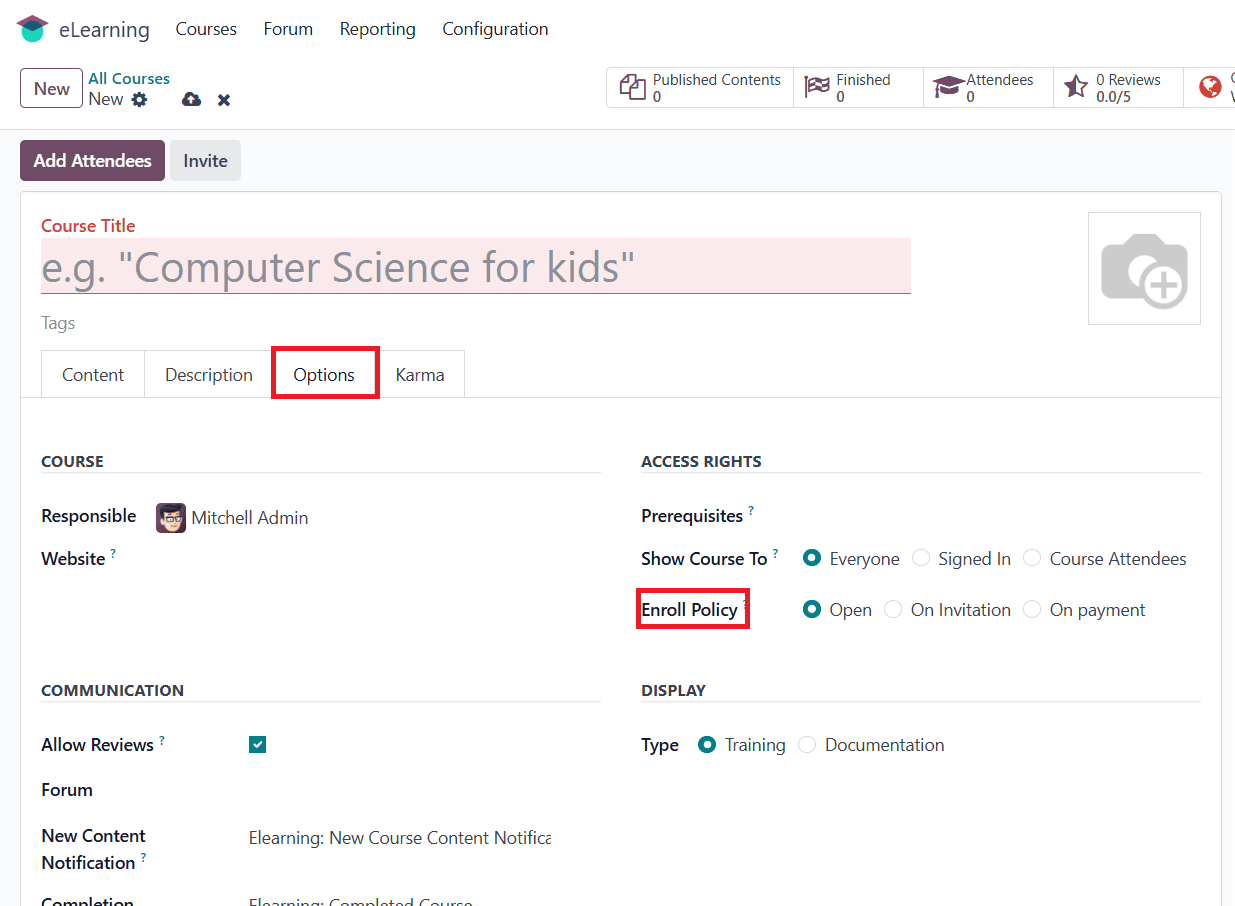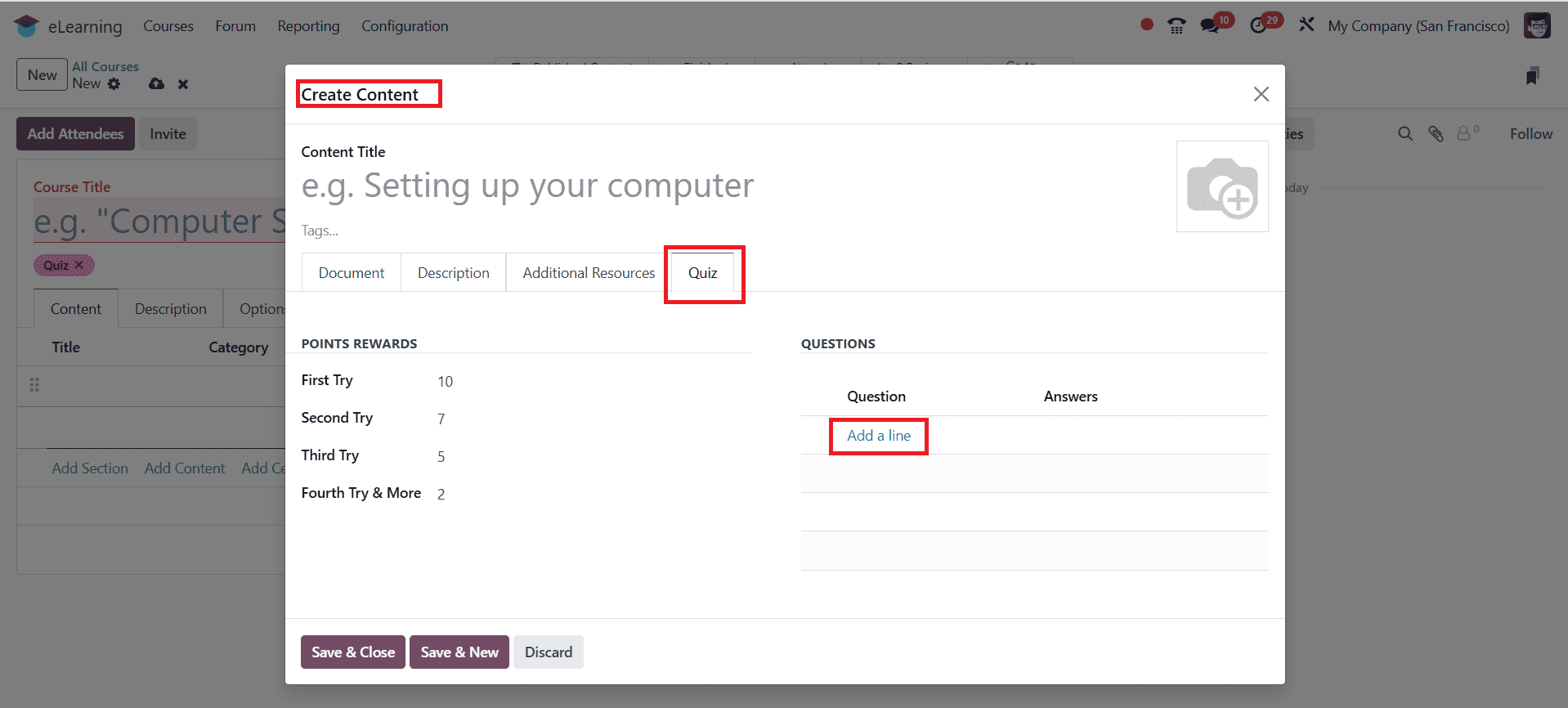An e-Learning module created within the business management program of Odoo 18, which enables the creation, administration, and delivery of online courses. The eLearning module is available in both Community and Enterprise editions, but they differ greatly in terms of features, integrations, support, and usability. The Community Edition is open-source and free and it introduces significant e-Learning functions. In contrast, the Enterprise edition is paid and offers more sophisticated features, automation tools, improved reportin,g and better integration with other Odoo applications.
1. Advanced Managing and Customising Courses:
Odoo Studio offers more sophisticated customizations with the Enterprise edition. This makes it possible to automate workflows, add new fields, change the layout, and reorganize courses without knowing how to program. Among the other features, the Enterprise edition offers managed learning paths, which enable administrators to establish a detailed plan for students to follow, thus promoting order in the learning process.
To customize courses, click on the New button as shown below:

Fill the Course Title and select a course you need to customize. In the Content Tab, use Add Section to organize courses into sections and use Add Content to attach different educational materials such as videos, documents or quizzes

In the Option tab, select an Enrollment Policy as Open or On Invitation
Or on Payment as shown below:

In the Quiz tab, click on Add a line to add questions, correct answers, and assign Points Rewards to evaluate participation and performance as shown below:

In the Description tab, explain a detailed overview of the course.

The Community edition is limited in its customization, requiring coding skills to make any changes to the eLearning module like development of courses, the division of content into sections, and quizzes. Custom development or third-party programs must be used to give more functionality.
2. Mobile Accessibility and the User Interface:
Enterprise edition has a modern, well-designed, and mobile-friendly interface. To ensure that every device is effortlessly accommodated in the learning process, the courses are adapted for smartphones and tablets. In today’s world, learners desire to access academic content anytime they want; this feature becomes really helpful.
In contrast, the Community edition’s interface is functional but simple. It lacks sophisticated design and mobile responsiveness, but it has the necessary features for managing e-learning platforms. This may make it challenging for students to attend the class without any problems using various devices.
3. Automation and Marketing:
Businesses may send automated course invitations, reminders, follow-up emails, and promotional campaigns in the Enterprise edition’s integration with the Odoo Marketing Automation module. This feature aids instructors in maintaining students’ interest so they stay involved and finish their courses. Organizations can also assess marketing performance to see what truly attracts students.
Student involvement and course promotion in the Community edition need to be done by hand. Promotional campaigns, targeted follow-ups, and email notifications cannot be automated with the built-in capabilities. The organization may find it challenging to encourage course enrollment and maintain student interest as a result.
4. Advanced reporting and Analytics:
Comprehensive documentation of the eLearning process is offered by the Enterprise edition’s sophisticated reporting features. The administrator has access to:
* Learner engagement metrics that evaluate involvement and communication
* Course performance comments that highlight both areas that need development and popular courses.
* Adaptable dashboards that give businesses a quick overview of critical performance metrics.
In this manner, organizations may make data-driven decisions about
enhancing learning outcomes and optimizing their training programs with the use of
of these analytics and others.
The Community edition will only offer basic data on student progress, including completion rates, quiz scores, and other comparable measures. Although it offers some helpful information about data, it doesn't reveal anything about the behaviour of students, their degree of engagement, or the efficacy of content-based learning.
5. Management of Certifications:
After a course is completed, course creators can award certifications in both editions; however, only the Enterprise edition has more sophisticated certification administration tools. For businesses utilizing the Enterprise edition, the following features are available:
* Create unique template certificates featuring signatures and brands
* Automate the issuance of certificates so that students can get proof as soon as they finish their classes.
* Establish due dates for certifications that learners must renew on a regular basis.
Businesses that provide professional training and certification programs
can use the Enterprise edition. Conversely, the Community edition offers minimal customization and standard templates for basic certification administration functions.
6. Learner Engagement and Gamification:
For online learning, engagement is crucial, and both editions include gamification features like ranks and badges. However, the Enterprise edition takes gamification a step further by including:
* A Leaderboard to promote student competition.
* A system of automatic incentives that gives students extra credit for finishing courses ahead of schedule.
* Customized suggestions that assist students in finding new courses that interest them.
7. Help Desk and Customer Support Integration:
The Enterprise edition’s integration with Odoo’s Help Desk module enables students to submit support tickets straight from the eLearning platform. This offers a seamless support experience and reduces response times. Administrators and instructors may monitor and address problems in a more effective way to enhance the learning environment as a whole.
Community edition lacks an integrated Help Desk; learner help must be manually managed using third-party technologies like chat or email. Delays in answers and ineffective problem-solving could result from this.
8. Enabling Access Control and Security:
The Community edition only provides limited role-based access control; the administrator is unable to precisely define user permissions. For a small eLearning project, this might be sufficient, but not for the kind of control security that businesses would need. On the other hand, the Enterprise edition has configurable security options. These consist of:
* Two-factor authentication, which adds an additional layer of security.
* Encryption and data-backup services, which safeguard sensitive information about students.
* Granular permissions for users, which enable the organization to decide which courses and resources are available to whom.
For businesses and educational institutions handling student information,
Enterprise edition is the best option.
Odoo 18 Community and Enterprise editions offer great performance in their eLearning module, allowing for the development of strong web applications. In order to sustain participation engagement, users can upload various kinds of information, establish learning objectives, control participant enrollment, evaluate students' progress, and implement reward systems. In order to create structured learning routes, the module also enables the design of courses that are separated into parts or units of information. Both editions include additional features like labelling, course descriptions, a forum, and the ability to add certifications via integrated surveys.
The difference between Odoo 18 Community edition and Enterprise edition depends on the organization’s financial constraints, technical capabilities, and desired features. Most startups, small enterprises, and individual teachers in need of a simple, affordable solution can use the Community Edition. The Enterprise edition, on the other hand, is more appropriate for businesses that require sophisticated automation, in-depth analytics, marketing tools, more robust security, and expert assistance. The Enterprise edition will ultimately benefit companies who wish to effectively scale their eLearning activities, while the Community edition might be more suitable for smaller customers.
To read more about What are the Differences Between Community & Enterprise in Odoo 18 Dashboard, refer to our blog What are the Differences Between Community & Enterprise in Odoo 18 Dashboard.